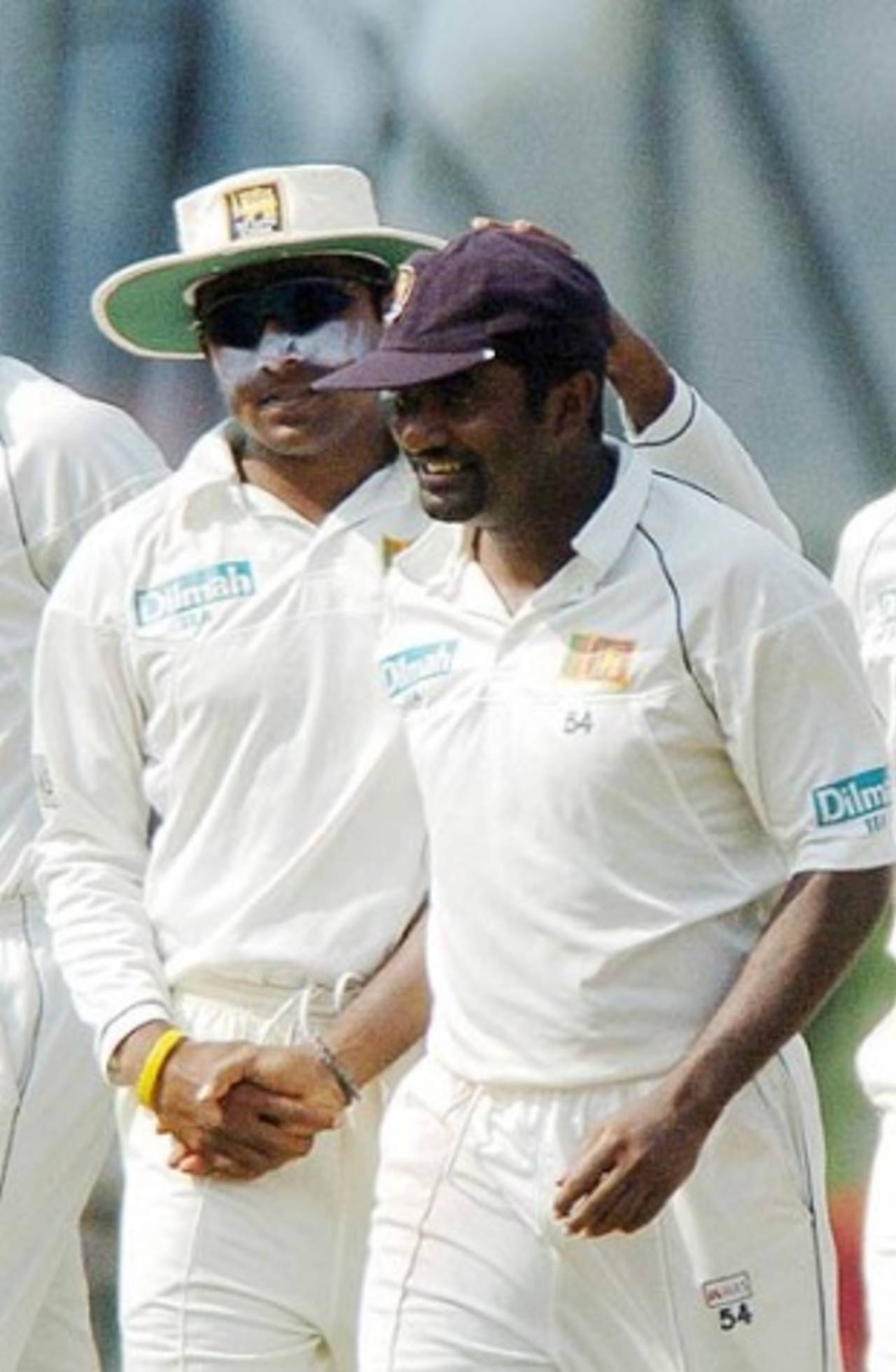Murali's magic, and Australian collapses
Five-fors and ten-fors against all teams, Raina's captaincy record, an update on ball changes, and more

c Jayawardene b Murali made 77 appearances in Tests • AFP
Muttiah Muralitharan, who seems to have declared his wonderful bowling innings closed at 800, took 112 wickets against England, 105 against India, and 104 against South Africa. His least favourite country was Australia: he took only 59 wickets against them (five of those in the Super Series Test for the World XI) at an average of 36.06. Murali also claimed 89 Bangladesh wickets, 87 Zimbabweans, 82 from both New Zealand and West Indies, and 80 from Pakistan.
That dismissal of Pragyan Ojha at Galle was indeed the 77th, and presumably final, time that "c Jayawardene b Muralitharan" will appear on a Test scorecard. And that is easily a record for a bowler-fielder combination: "c Dravid b Kumble" is next with 55, just ahead of "c Taylor b Warne" (51). The record for a bowler-wicketkeeper pairing remains "c Marsh b Lillee", with 95. For the full list (which also shows wicketkeepers), click here.
Well, the only one to do it is a just-retired Sri Lankan... Muttiah Muralitharan took at least five five-fors against all the other nine Test sides (for these purposes I'm ignoring the World XI), and he also took 10 in a match against everyone (Australia, New Zealand and Pakistan only once each). The only country in which he failed to take a five-for was Australia, where his best innings analysis in five Tests was 3 for 55. Murali's nearest challenger, Shane Warne, never took five in an innings against Zimbabwe (he only faced them in one Test), and did not manage ten-fors against Bangladesh, India, New Zealand, West Indies or Zimbabwe.
Australia's collapse for 88 against Pakistan at Headingley last week was actually the ninth time they had been bowled out in a Test without any batsman reaching 20 (the highest score was Tim Paine's 17). Five of those instances were in the 19th century, and another one was in 1902: the only two since then occurred against West Indies in Port-of-Spain in 1977-78, when the highest score in a total of 94 was Graham Yallop's 18, and in Melbourne in 1980-81, when India skittled Australia for 83 and Doug Walters' unbeaten 18 was the highest score. The biggest Test total in which no one reached 20 is Bangladesh's 134 against Pakistan in Multan in 2001-02, when the highest individual contribution was Mehrab Hossain's 19 - but seven other batsmen (and extras) made it into double figures.
Rather surprisingly, perhaps, Australia had made six scores lower than their 88 at Headingley last week after winning the toss and deciding to take first strike. Their lowest remains 53, against England at Lord's in 1896. For a full list, click here. The lowest total made by any side that won the toss and batted is 36, by South Africa on a treacherous pitch in Melbourne in 1931-32 (they made only 45 in their second innings). That match produced the lowest run-aggregate in any Test - 234 - and only 10 fours were hit in the whole game, the lowest-known tally of boundaries in a completed Test, to answer a separate question from Kalaikovan Ramamurthy.
Suresh Raina played in a record 98 one-day internationals before finally winning a Test cap against Sri Lanka, and did indeed captain India in their four ODIs in the recent triangular series in Zimbabwe. He broke the previous mark of 94 ODIs before playing a Test, set by Australia's Andrew Symonds. The only other people to have captained a Test-playing country in ODIs before playing in a Test themselves (excluding those who played before their teams were awarded Test status) are Clive Rice, who skippered South Africa in their first three one-dayers after they were readmitted to official international cricket in 1991-92 (he was then dropped and never did play a Test), and the New Zealander Gavin Larsen, who captained in three matches in Sharjah in April 1994 before making his Test debut in England later that same year.
Some readers have suggested that Frank Worrell did not have any choice other than to continue with the ball that was eventually used for 185.3 overs in Bridgetown in 1961-62. The regulations at the time often permitted a new ball to be taken only when the batting side had reached 200 - and India never got there, as they scored at a fraction above one an over and were eventually all out for 187. I've made enquiries about whether this was the case here, without a definite answer yet. Charles Davis from Melbourne adds: "In England in 1961, some new balls were taken after 85 overs (and before 200 runs), while others were taken at 200 runs, before 85 overs. However, in Australia in 1962-63, the new ball was only ever taken after 200 runs (sometimes quite early if scoring was fast), just as it had been for decades. In India, it was still 200 runs in 1964-65. I don't for sure know how the rule worked in the West Indies at the time. However, scorebooks from 1953-54, 1957-58 and 1964-65 suggest that it was measured in overs not runs, so Worrell might have had a choice in 1961-62 after all."
Steven Lynch is the editor of the Cricinfo Guide to International Cricket. If you want to ask Steven a question, use our feedback form. The most interesting questions will be answered here each week. Ask Steven is now on Facebook